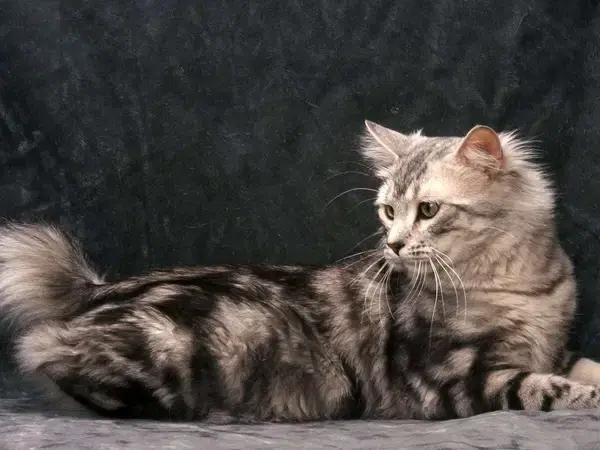They’re trying to send you a secret message that only the other cats in the world can decode. Or maybe, just maybe, they're preparing for a grand ninja-style attack on that rogue feather duster.
Okay, we’re kidding. The fact that it’s a cat, anything is possible. But tail swinging isn’t just a sign of dramatic flair or feline sass. The tail is the mood barometer for cats. So, yes, it could be them planning an attack on you because you dared to sit in their spot or just them contemplating the meaning of life (or the mystery of the food bowl being half-empty).
Cats use their tails as a medium of communication or expression. You would’ve seen your cat’s tail being straight up, held like a question mark, held low to the ground, fluffed up, or even wrapped around their own body at times. Each of these has a different meaning. Today particularly, we’ll be talking about cats and their swishing tails.
Here are the possible reasons why cats swish their tails – (1)
Playing
The tail swishing itself is not the game, but it can indicate that the cat is in a playful mood. You’ll see this when they are playing with toys or other cats. The movement here will often be fluid and relaxed and may be accompanied by dilated pupils and forward-pointing ears.
Hunting
Cats use their tails to achieve balance before pouncing on their prey. The movement here would be slow. Your domestic cat may not need to go hunting but you may see this when they are about to jump.
Annoyance
If you see the cat’s tail swish rapidly, it would be better to leave them alone for some time. It is usually an indication that they are annoyed and want to be left alone. You may also see a low and stiff tail, wagging sideways when you’re petting them. This is usually a sign that they are feeling over-stimulated and want you to stop.
Excitement
The same tail can be swishing rapidly to tell you that they are excited to see you. The context is what matters here. You may also want to observe other body language cues to take a call.
Pain or discomfort
If you notice a change in your cat’s tail wagging pattern and if there are other symptoms like lethargy, lack of appetite, etc., there may be a chance of underlying pain or discomfort for your cat.
Acknowledgement
You may see your cat wagging their tail when you call their name or are talking about them to someone else. It is their way of acknowledging it and showing excitement.
Why do cats swish their tails while lying down?
If your cat is sleeping and you see the tail swishing, it’s probably because they are dreaming. It may be a bird hunt, a delicious dinner, or you stroking them in the dream, making the tail wag. It may also be a response to a nightmare. (1)
If your cat is just lying down and swishing their tail, it could be a sign of discomfort or pain. Along with swishing, if you see other signs like restlessness or lack of appetite, you must take them to a vet. If not because of pain, they could be wagging their tail because of fear as well. If they hear a vacuum cleaner or anything that looks like a predator to them, you may see a stiff, swishing tail. (1)
Be careful if you do because they are likely to be easily annoyed in that position. You may be greeted with hissing and growling if you add to that annoyance in any way. And by any way, it could also be your mere presence.
Are cats happy when they swish their tails?
Not necessarily, but yes, cats do swish their tails when they are happy. It could be the excitement of you coming back home from work or the contentment when you stroke them. They also tend to swish their tails while playing with toys or other cats. A slow swish with the tail held high is usually an indication of a happy and content cat.
What does a cat flicking its tail mean?
Depending on the context and the way the cat is flicking their tail, it could mean anything from a sign of excitement, fear, annoyance, happiness, affection or agitation.
It is important to understand cats and their body language, as it will play a very important role in developing a deeper relationship between you and your cat.
More About Spot Pet Insurance
Understanding the body language of cats is also very important as it helps owners identify the chances of their cat being sick. Your cat maybe prone to multiple illnesses and injuries during its lifetime. Some may be minor, but others may need extensive treatment. The treatment may also require proper diagnostics including X-rays, blood tests, etc.
You probably were aware of these facts. But did you know that with pet health insurance, you can save up to 90% of the associated treatment costs?
With a Spot accident and illness plan, you can take your cat for treatment at any licensed vet in Canada or the U.S. Spot plans don’t have networks, so whether you’re home or traveling within the U.S, veterinary services your cat receives for the diagnosis, treatment, or management of eligible services can be covered. Spot’s accident and illness plans can help cover a variety of conditions, ranging from broken bones and bite wounds to behavioral conditions, and cancer. While base plans do not offer coverage for preventive care services, Spot’s Wellness Riders can be added to any base plan for an additional fee and can help cover the eligible costs of wellness exams, vaccinations, dental cleanings, and more!
Learn more about cat insurance or get a free quote!

I've had the privilege of immersing myself in the realm of pet safety. As the owner of an energetic mini golden doodle, I know just how stressful being a pet owner can be. I am dedicated to ensuring our beloved pets enjoy a life brimming with good health.
Sheba® UK. (n.d.). Find out Why do cats wag their tails? | SHEBA® UK. https://www.uk.sheba.com/blog/bonding-care/why-do-cats-wag-their-tails
Behavior, A. G. D. (2024, January 11). How To Read Your Cat's Tail Language. https://www.petmd.com/cat/behavior/cat-tail-language












